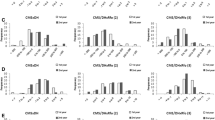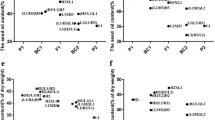Abstract
Chinese semi-winter rapeseed is genetically diverse from Canadian and European spring rapeseed. This study was conducted to evaluate the potential of semi-winter rapeseed for spring rapeseed hybrid breeding, to assess the genetic effects involved, and to estimate the correlation of parental genetic distance (GD) with hybrid performance, heterosis, general combining ability (GCA) and specific combining ability (SCA) in crosses between spring and semi-winter rapeseed lines. Four spring male sterile lines from Germany and Canada as testers were crossed with 13 Chinese semi-winter rapeseed lines to develop 52 hybrids, which were evaluated together with their parents and commercial hybrids for seed yield and oil content in three sets of field trials with 8 environments in Canada and Europe. The Chinese parental lines were not adapted to local environmental conditions as demonstrated by poor seed yields per se. However, the hybrids between the Chinese parents and the adapted spring rapeseed lines exhibited high heterosis for seed yield. The average mid-parent heterosis was 15% and ca. 50% of the hybrids were superior to the respective hybrid control across three sets of field trials. Additive gene effects mainly contributed to hybrid performance since the mean squares of GCA were higher as compared to SCA. The correlation between parental GD and hybrid performance and heterosis was found to be low whereas the correlation between GCA(f + m) and hybrid performance was high and significant in each set of field trials, with an average of r = 0.87 for seed yield and r = 0.89 for oil content, indicating that hybrid performance can be predicted by GCA(f + m). These results demonstrate that Chinese semi-winter rapeseed germplasm has a great potential to increase seed yield in spring rapeseed hybrid breeding programs in Canada and Europe.
Similar content being viewed by others
References
Ali M, Copeland LO, Elias SG, Kelley JD (1995) Relationship between genetic distance and heterosis for yield and morphological traits in winter canola (Brassica napus L.). Theor Appl Genet 91:118–121
Beck DL, Vasal SK, Crossa J (1991) Heterosis and combining ability among subtropical and temperate intermediate-maturity maize germplasm. Crop Sci 31:68–73
Becker HC, Engqvist GM, Karlsson B (1995) Comparison of rapeseed cultivars and resynthesized lines based on allozyme and RFLP markers. Theor Appl Genet 91:62–67
Brandle JE, McVetty PBE (1990) Geographical diversity, parental selection and heterosis in oilseed rape. Can J Plant Sci 70:935–940
Butruille DV, Guries RP, Osborn TC (1999) Increasing yield of spring oilseed rape hybrids through introgression of winter germplasm. Crop Sci 39:1491–1496
Cheres MT, Miller JF, Crane JM, Knapp SJ (2000) Genetic distance as a predictor of heterosis and hybrid performance within and between heterotic groups in sunflower. Theor Appl Genet 100:889–894
Comstock RE, Robinson HF (1952) Estimation of the average dominance of genes. In: Gowen JW (ed) Heterosis. The Iowa State College Press, Ames, pp 494–516
Crossa J, Vasal SK, Beck DL (1990) Combining ability estimates of CIMMYT tropical late yellow maize germplasm. Maydica 35:273–278
Dhillon BS, Gurrath PA, Zimmer E, Wermke M, Pollmer WG, Klein D (1990) Analysis of diallel crosses of maize for variation and covariation in agronomic traits at silage and grain harvests. Maydica 35:297–302
Diers BW, Osborn TC (1994) Genetic diversity of oilseed Brassica napus germ plasm based on restriction fragment length polymorphism. Theor Appl Genet 88:662–668
Diers BW, McVetty PBW, Osborn TC (1996) Relationship between heterosis and genetic distance based on restriction fragment length polymorphism markers in oilseed rape (Brassica napus L.). Crop Science 36:79–83
Frary A, Fulton TM, Zamir D, Tanksley SD (2004) Advanced backcross QTL analysis of a Lycopersicon esculentum × L. pennellii cross and identification of possible orthologs in the Solanaceae. Theor Appl Genet 108:485–496
Gao ZR (1986) Quantitative genetics. Sichuan University Press, Chengdu, pp 414–433
Gómez-Campo C (1999) Biology of Brassica coenospecies. Elsevier Press, Netherlands, pp 33–58
Grant I, Beversdorf WD (1985) Heterosis and combining ability estimates in spring oilseed rape (Brassica napus L.). Can J Genet Cytol 27:472–478
Huang XQ, Coster H, Ganal MW, Roder MS (2003) Advanced backcross QTL analysis for the identification of quantitative trait loci alleles from wild relatives of wheat (Triticum aestivum L.). Theor Appl Genet 106:1379–1389
Lefort-Buson M, Guillot-Lemoine B, Dattee Y (1987) Heterosis and genetic distance in rapeseed (Brassica napus L.): crosses between European and Asiatic selfed lines. Genome 29:413–418
Li MT, Li ZY, Zhang CY, Qian W, Meng JL (2005) Reproduction and cytogenetic characterization of interspecific hybrids derived from cross between Brassica carinata and B. rapa. Theor Appl Genet 110:1284–1289
Li M, Chen X, Meng J (2006) Intersubgenomic heterosis in rapeseed production with a partial new-typed Brassica napus containing subgenome Ar from B. rapa and Cc from Brassica carinata. Crop Sci 46:234–242
Liu XC, Wu JL (1998) SSR heterogenic patterns of parents for marking and predicting heterosis in rice breeding. Mol Breed 3:263–268
Ma C, Kimura Y, Fujimoto H, Sakai T, Imamura J, Fu T (2000) Genetic diversity of Chinese and Japanese rapeseed (Brassica napus L.) varieties detected by RAPD markers. Breeding Sci 50:257–265
Melchinger AE (1999) Genetic diversity and heterosis. In: Coors CG, Pandey S (eds) Genetic and exploitation of heterosis in crops. American Society of Agronomy, Madison, pp 99–118
Melchinger AE, Gumber RK (1998) Overview of heterosis and heterotic groups in agronomic crops. In: Lamkey KR, Staub JE (eds) Concepts and breeding of heterosis in crop plants. CSSA, Madison, pp 29–44
Nei M, Li WH (1979) Mathematical model for studying genetic variation in terms of restriction endouncleases. PNAS 76:5269–5273
Qian W, Liu R, Meng J (2003) Genetic effects on biomass yield in interspecific hybrids between Brassica napus and B. rapa. Euphytica 134:9–15
Qian W, Chen X, Fu D, Zou J, Meng J (2005) Intersubgenomic heterosis in seed yield potential observed in a new type of Brassica napus introgressed with partial Brassica rapa genome. Theor Appl Genet 110:1187–1194
Qian W, Meng J, Li M, Frauen M, Sass O, Noack J, Jung C (2006) Introgression of genomic components from Chinese Brassica rapa contributes to widening the genetic diversity in rapeseed (B. napus L.), with emphasis on the evolution of Chinese rapeseed. Theor Appl Genet 113:49–54
Quijada PA, Udall JA, Polewicz H, Vogelzang RD, Osborn TC (2004) Phenotypic effects of introgressing French winter germplasm into hybrid spring canola. Crop Sci 44:1982–1989
Reif JC, Melchinger AE, Xia XC, Warburton ML, Hoisington DA, Vasal SK, Beck D, Bohn M, Frisch M (2003) Use of SSRs for establishing heterotic groups in subtropical maize. Theor Appl Genet 107:947–957
Reif JC, Maurer HP, Kömle S, Schön CC (2006) Theortical and experimental investigations on optimum exploitation of heterosis utilizing the concept of heterotic patterns in hybrid breeding. In: International symposium: heterosis in plants, Potsdam-Golm, Germany May 18–20
Riaz A, Li Q, Quresh Z, Swati MS, Quiros CF (2001) Genetic diversity of oilseed Brassica napus inbred lines on sequence-related amplified polymorphism and its relation to hybrid performance. Plant Breeding 120:411–415
SAS Institute Inc. (1992) SAS Technical Report. SAS statistics Software: changes and enhancements. Release 6.07. SAS Institute Inc., Cary, North Carolina
Septiningsih EM, Prasetiyono J, Lubis E, Tai TH, Tjubaryat T, Moeljopawiro S, McCouch SR (2003) Identification of quantitative trait loci for yield and yield components in an advanced backcross population derived from the Oryza sativa variety IR64 and the wild relative O. rufipogon. Theor Appl Genet 107:1419–1432
Smith OS, Smith JSC, Bowen SL, Tenborg RA, Wall SJ (1990) Similarities among a group of elite maize inbreds as measured by pedigree, F1 grain yield, grain yield heterosis, and RFLPs. Theor Appl Genet 80:833–840
Song KM, Lu P, Tang K, Osborn TC (1995) Rapid genome change in synthetic polyploids of Brassica and its implication for polyploid evolution. PNAS 92:7719–7723
Song KM, Osborn TC, Williams PH (1988a) Brassica taxonomy based on nuclear restriction fragment length polymorphism (RFLP) 2. Preliminary analysis of subspecies within B. rapa. Theor Appl Genet 76:593–600
Song KM, Osborn TC, Williams PH (1988b) Brassica taxonomy based on nuclear restriction fragment length polymorphism (RFLP) 1.Genome evolution of diploid and amphidiploid species. Theor Appl Genet 75:784–794
Teklewold A, Becker HC (2006) Comparison of phenotypic and molecular distance to predict heterosis and F1 performance in Ethiopian mustard (Brassica carinata A. Braum). Theor Appl Genet 112:752–759
U N (1935) Genomic analysis in Brassica with specific reference to the experimental formation of B. napus and peculiar mode of ferilization. Jpn J Bot 7:389–452
Udall JA, Quijada PA, Polewicz H, Vogelzang R, Osborn TC (2004) Phenotypic effects of introducing unadapted germplasm into a spring canola hybrid. Crop Sci 44:1990–1996
Udall JA, Quijada PA, Lambert B, Osborn TC (2006) Quantitative trait analysis of seed yield and other complex traits in hybrid spring rapeseed (Brassica napus L.): 2. identification of alleles from unadapted germplasm. Theor Appl Genet 113:597–609
Vasal SK, Srinivasan G, Crossa J, Beck DL (1992a) Heterosis and combining ability of CIMMYT’s subtropical and temperate early maturity maize germplasm. Crop Sci 32:884–890
Vasal SK, Srinivasan G, Beck DL, Crossa J, Pandey S, Leon C de (1992b) Heterosis and combining ability of CIMMYT’s tropical late white maize germplasm. Maydica 37:217–223
Vasal SK, Srinivasan G, Gonzalez F, Han GC, Pandey S, Beck DL, Crossa J (1992c) Heterosis and combining ability of CIMMYT’s tropical × subtropical maize germplasm. Crop Sci 32:1483–1489
Yu C, Hu SW, Zhao HX, Guo AG, Sun GL (2005) Genetic distances revealed by morphological characters, isozymes, proteins and RAPD markers and their relationships with hybrid performance in oilseed rape (Brassica napus L.). Theor Appl Genet 110:511–518
Zhang Q, Gao YJ, Yang SH, Ragab RA, Saghai Maroof MA, Li ZB (1994) A half-diallel analysis of heterosis in elite hybrid rice based on RFLP and microsatellites. Theor Appl Genet 89:185–192
Zhang Q, Zhou ZQ, Yang GP, Xu CG, Liu KD, Saghai Maroof MA (1996) Molecular marker heterozygosity and hybrid performance in indica and japonica rice. Theor Appl Genet 93:1218–1224
Zhao J, Wang X, Deng B, Lou P, Wu J, Sun R, Xu Z, Vromans J, Koornneef M, Bonnema G (2005) Genetic relationship within Brassica rapa as inferred from AFLP fingerprints. Theor Appl Genet 110:1301–1314
Acknowledgments
This work was supported by the “Forschungs- und Entwicklungsfonds Raps”. We sincerely acknowledge the help of Dr. V. Marwede, Mr. F.H. Jensen for running the field trials in Canada and Denmark. We thank Prof. Dr. M. Hühn and Dr. A.E. Müller for critically reading the manuscript.
Author information
Authors and Affiliations
Corresponding author
Additional information
Communicated by T. Lübberstedt.
Rights and permissions
About this article
Cite this article
Qian, W., Sass, O., Meng, J. et al. Heterotic patterns in rapeseed (Brassica napus L.): I. Crosses between spring and Chinese semi-winter lines. Theor Appl Genet 115, 27–34 (2007). https://doi.org/10.1007/s00122-007-0537-x
Received:
Accepted:
Published:
Issue Date:
DOI: https://doi.org/10.1007/s00122-007-0537-x




